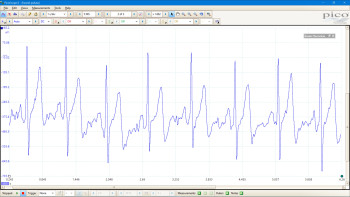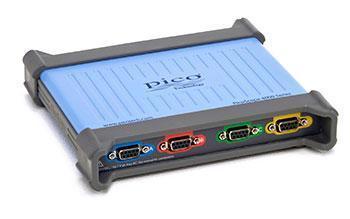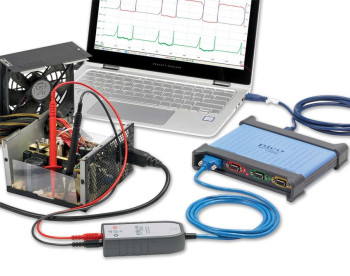High-resolution differential USB oscilloscope
The PicoScope 4444 and its accessories offer accurate and detailed measurement for a multitude of applications.
Key features
- 4 fully differential high-impedance inputs
- 20 MHz bandwidth
- Flexible 12 and 14-bit resolution
- 256 MS deep memory
- Rejects common-mode noise
- Interface for intelligent probes and clamps
- Low-voltage probe for millivolts to 50 V
- 1000 V CAT III voltage and current probes for mains measurement applications
Typical applications
- Non-ground-referenced measurements
- Safe probing of single-phase and three-phase voltages and currents
- Measuring power drawn by mobile and IoT devices
- Mains quality testing
- SMPS design
- Hybrid and electric vehicle design
- Motor drives and inverters
- Biomedical electronics
- Measuring differential signals (CAN, balanced audio) with a single channel
High-end oscilloscope
At the heart of every PicoScope 4444 is an advanced oscilloscope that offers everything you would expect and much more, including:
- 10 000 waveform circular buffer
- Up to 100 000 waveforms per second update rate
- Serial bus decoding
- Mask limit testing
- Advanced math and filtering
- Measurements with statistics
- Advanced digital triggering
- USB 3.0 connected and powered
More details on the above and many other options can be found under the Features tab.

Intelligent differential inputs
With a traditional oscilloscope probe, single-ended measurements are made between a high-impedance input and a low-impedance ground.
With a differential oscilloscope, measurements are made between two high-impedance inputs, allowing measurements to be made across components and test points where neither side is grounded. Differential inputs also reject common-mode noise: noise picked up equally on both high-impedance inputs is rejected.
Each of the four input channels on the PicoScope 4444 features an intelligent probe interface that detects and identifies compatible probes, and powers them where necessary. Each channel can have its own choice of voltage or current probe.
Non-attenuating probes allow high-resolution, low-noise measurement of signals ranging from millivolts to ±50 V. Attenuating probes allow signals up to 1000 V CAT III to be measured. Current probes are available for currents up to 2000 A, also rated for 1000 V CAT III measurements.
PicoConnect 441: Measure from millivolts to ±50 V
The PicoConnect 441 differential voltage probes are suitable for voltages up to ±50 V (for higher voltages see the PicoConnect 442). The probes are fitted with industry-standard 4 mm connectors and supplied with detachable sprung hook probe tips. Other 4 mm accessories such as multimeter probes and crocodile clips are available separately.
As well as measuring non-grounded voltage signals, differential inputs are ideal for measuring current through sensing resistors. As neither side needs to be grounded, they can make high-side measurements. The sensitive input ranges, high resolution and fast sampling are ideal for measuring fast-changing currents in battery-powered and IoT devices.
Human heartbeat captured on PicoScope 4444
The high-impedance, high-resolution inputs are also suited to biological and scientific research, as they allow measurements on low-level millivolt signals (2 mV/div at 12 bits) in the presence of common-mode noise without the need for expensive differential preamplifiers or differential oscilloscope probes. The probe is constructed with twinax cable (twisted-pair inner conductors with an outer shield) to ensure a high common-mode rejection ratio (CMRR). The outer screen of the cable can optionally be connected to a signal ground to improve rejection of common mode voltages and currents.
The PicoConnect 441 probes are also ideal for measuring differential signal sources such as CAN bus and balanced audio on a single channel, and can be used to directly measure from bridge-type sensors such as load cells and pressure sensors.
PicoConnect 441 probes are ideal for work with low voltage SMPS, PicoConnect 442 (shown) for voltages up to 1000 V.

PicoConnect 442: 1000 V CAT III probes
The PicoConnect 442 is an attenuating differential voltage probe that increases the input range to 1000 V to allow the safe and cost-effective measurement of single-phase, three-phase and other signals, such as those found in motor drives and inverters.
The PicoConnect 442 probe requires no power supply or batteries. This makes it ideal for mains quality measurement and other long-term measurements.
The differential inputs of the PicoScope 4444 allow each channel to measure signals with different common-mode voltages. As an example, consider the battery pack in an electric vehicle. You can measure across the whole pack using one channel set to an input range of ±500 V, and at the same time set the other channels to ±5 V to measure across individual cells. This arrangement allows you to take advantage of the full resolution of the oscilloscope.
Three current probes with intelligent probe interface
Three different current probes are available with Pico D9 interfaces. TA300 and TA301 use the Hall effect to measure AC and DC currents without direct connection to the cable, and the TA368 uses the Rogowski principle for AC-only measurements. The intelligent probe interface powers the probes, so no batteries are required. It also means that when you connect either probe, the PicoScope software identifies it and configures the oscilloscope to read in amperes.
The TA300 current probe is a 40 A probe suitable for measuring signals from DC to 100 kHz. It is a precision probe for smaller currents and can resolve down to a few milliamps.
Read more about the TA300 40 A AC/DC current probe
The TA301 current probe is a switched-range 200/2000 A probe suitable for measuring signals from DC to 20 kHz bandwidth.
Read more about the TA301 2000 A AC/DC current probe
The TA368 current probe is a single-range 2000 A AC probe suited for measuring signals above DC to 20 kHz, and because the probe is rated to 1000 V CAT III, it is ideal for making mains current measurements.
Read more about the TA368 2000 A AC current probe
In addition to the above probes, Pico stocks a wide range of AC and DC current clamps with BNC connectors that can be connected to the PicoScope 4444 using the TA271 D9 to BNC adaptor.
Powerful and portable
Just load the software, plug in the USB cable and you are up and running in minutes. Saving and printing are easy: PicoScope users can take copying waveforms into reports for granted.
On the bench, a PicoScope saves valuable space and can be placed right by the unit under test.
Laptop users benefit even more: with no power supply required you can now carry an oscilloscope with you all the time in your laptop bag. Perfect for the engineer on the move.
With our scopes, high-end features such as serial decoding, mask limit testing, advanced math channels and segmented memory are all included in the price.
To protect your investment, both the PC software and firmware inside the scope can be updated. Pico has a 26-year history of providing new features for free through software downloads. We deliver on our promises of future enhancements year after year.
Users of our products reward us by becoming lifelong customers and frequently recommending us to their colleagues.
| Vertical | ||
|---|---|---|
| Oscilloscope specifications | Specifications with PicoConnect 442 1000 V CAT III probe | |
| Input channels | 4 channels | 4 channels |
| Analog bandwidth (–3 dB) | 20 MHz with D9 to BNC adaptors 15 MHz with PicoConnect 441 probe |
10 MHz |
| Rise time (calculated) | 17.5 ns with D9 to BNC adaptors 23 ns with PicoConnect 441 probe |
35 ns |
| Bandwidth limit | 100 kHz or 1 MHz (selectable) | 100 kHz or 1 MHz (selectable) |
| Vertical resolution, 12-bit mode | 12 bits on most input ranges 11 bits on ±10 mV range |
12 bits |
| Vertical resolution, 14-bit mode | 14 bits on most input ranges 13 bits on ±20 mV range 12 bits on ±10 mV range |
14 bits |
| Enhanced vertical resolution 12-bit mode |
16 bits on most input ranges 15 bits on ±10 mV range |
16 bits |
| Enhanced vertical resolution 14-bit mode |
18 bits on most input ranges 17 bits on ±20 mV range 16 bits on ±10 mV range |
18 bits |
| Input type | Differential 9-pin D-subminiature, female |
Differential 9-pin D-subminiature, female |
| Input characteristics | 1 MΩ ±1%, in parallel with 17.5 pF ±1 pF (each differential input to ground). < 1 pF difference between ranges. |
16.7 MΩ ±1%, in parallel with 9.3 pF ±1 pF (each differential input to ground) |
| Input coupling | AC/DC | AC/DC |
| Input sensitivity (10 vertical divisions) |
2 mV/div to 10 V/div | ±0.5 V/div to ±200 V/div |
| Input ranges (full scale) | ±10 mV, ±20 mV, ±50 mV, ±100 mV, ±200 mV, ±500 mV, ±1 V, ±2 V, ±5 V, ±10 V, ±20 V, ±50 V |
±2.5 V, ±5 V, ±12.5 V, ±25 V, ±50 V, ±125 V, ±250 V, ±500 V, ±1000 V |
| Input common mode range | ±5 V on ±10 mV to ±500 mV ranges ±50 V on ±1 V to ±50 V ranges |
±125 V on ±2.5 V to ±12.5 V ranges ±1000 V on ±25 V to ±1000 V ranges |
| DC accuracy (DC to 10 kHz) | ±1% of full scale ±500 µV | ±3% of full scale ±12.5 mV |
| Analog offset range | ±250 mV on ±10 mV to ±500 mV ranges ±2.5 V on ±1 V to ±5 V ranges ±25 V on ±10 V to ±50 V ranges |
±6.25 V on ±2.5 V to ±12.5 V ranges |
| Analog offset accuracy | 1% of offset setting in addition to basic DC accuracy | 1% of offset setting in addition to basic DC accuracy |
| Overvoltage protection | ±100 V DC + AC peak (any differential input to ground) ±100 V DC + AC peak (between differential inputs) |
CAT III 1000V |
| Horizontal | |
|---|---|
| Maximum sampling rate (real-time) 12-bit mode |
1 channel: 400 MS/s 2 channels: 200 MS/s 3 or 4 channels: 100 MS/s |
| Maximum sampling rate (real time) 14-bit mode |
50 MS/s |
| Maximum sampling rate (USB streaming) | 16.67 MS/s |
| Shortest real-time collection time, 12-bit mode |
50 ns (5 ns/div) |
| Shortest real-time collection time, 14-bit mode |
200 ns (20 ns/div) |
| Longest real-time collection time | 50000 s (5000 s/div) |
| Capture memory (block mode) | 256 MS shared between active channels |
| Capture memory (USB streaming mode) | 100 MS (shared between active channels) |
| Waveform buffers | 10000 |
| Collection time accuracy | ±50 ppm (5 ppm/year aging) |
| Sample jitter | 3 ps RMS typical |
| ADC sampling | Simultaneous sampling on all enabled channels |
| Dynamic performance (typical) | ||
|---|---|---|
| Oscilloscope specifications | Specifications with PicoConnect 442 1000 V CAT III probe | |
| Crosstalk | 2000:1 (DC to 20 MHz) | 2000:1 (DC to 10 MHz) |
| Harmonic distortion at 100 kHz, 90% FSD | < –70 dB on ±50 mV ranges and higher < –60 dB on ±10 mV and ±20 mV ranges |
< –70 dB |
| SFDR | > 70 dB | > 70 dB |
| ADC ENOB, 12-bit mode | 10.8 bits | 10.8 bits |
| ADC ENOB, 14-bit mode | 11.8 bits | 11.8 bits |
| Noise | < 180 µV RMS on ±10 mV range | < 5 mV RMS on ±2.5 V range |
| Bandwidth flatness | (+0.1 dB, –3 dB) DC to full bandwidth | (+0.1 dB, –3 dB) DC to full bandwidth |
| Common mode rejection ratio | 60 dB typical, DC to 1 MHz | 55 dB typical, DC to 1 MHz |
| Triggering | ||||||
|---|---|---|---|---|---|---|
| Source | Any input channel | |||||
| Trigger modes | None, auto, repeat, single, rapid | |||||
| Advanced triggers | Edge, window, pulse width, window pulse width, dropout, window dropout, interval, runt, logic | |||||
| Trigger sensitivity | Digital triggering provides up to 1 LSB accuracy up to full bandwidth | |||||
| Maximum pre-trigger | Up to 100% of capture size | |||||
| Trigger time-delay range | Up to 4 billion samples | |||||
| Trigger rearm time in rapid trigger mode | < 2 µs on fastest timebase | |||||
| Max. waveforms in rapid trigger mode | 10000 waveforms in a 12 ms burst | |||||
| Probe compensation pins | ||||||
|---|---|---|---|---|---|---|
| Output level | 4 V peak | |||||
| Output impedance | 610 Ω | |||||
| Output waveforms | Square wave | |||||
| Output frequency | 1 kHz | |||||
| Overvoltage protection | ±10 V | |||||
| Spectrum analyzer | |||||||
|---|---|---|---|---|---|---|---|
| Frequency range | DC to analog bandwidth of oscilloscope | ||||||
| Display modes | Magnitude, average, peak hold | ||||||
| Windowing functions | Rectangular, Gaussian, triangular, Blackman, Blackman-Harris, Hamming, Hann, flat-top | ||||||
| Number of FFT points | Selectable from 128 to half available buffer memory in powers of 2, up to a maximum of 1 048 576 points | ||||||
| Math channels | |
|---|---|
| General functions | −x, x+y, x−y, x*y, x/y, x^y, sqrt, exp, ln, log, abs, norm, sign, sin, cos, tan, arcsin, arccos, arctan, sinh, cosh, tanh, derivative, integral, delay |
| Filter functions | Lowpass, highpass, bandstop, bandpass |
| Graphing functions | Frequency, duty cycle |
| Multi-waveform functions | Min, max, average, peak |
| Operands | Input channels, reference waveforms, time, constants, pi |
| Automatic measurements | |
|---|---|
| Scope mode | AC RMS, true RMS, frequency, cycle time, duty cycle, DC average, edge count, falling edge count, rising edge count, falling rate, rising rate, low pulse width, high pulse width, fall time, rise time, minimum, maximum, peak to peak |
| Spectrum mode | Frequency at peak, amplitude at peak, average amplitude at peak, total power, THD %, THD dB, THD+N, SFDR, SINAD, SNR, IMD |
| Statistics | Minimum, maximum, average and standard deviation |
| Serial decoding | |||||
|---|---|---|---|---|---|
| Protocols | 1-Wire, ARINC 429, CAN, CAN FD, DALI, DCC, DMX512, Ethernet 10Base-T, FlexRay, I²C, I²S, LIN, Manchester, MODBUS, PS/2, SENT, SPI, UART (RS-232 / RS-422 / RS-485), USB 1.0/1.1 | ||||
| Mask limit testing | |||||||
|---|---|---|---|---|---|---|---|
| Mask generation | Numeric (automatic) or graphical (manual) | ||||||
| Statistics | Pass/fail, failure count, total count | ||||||
| Available actions on mask fail | Beep, play sound, stop capture, save waveform, trigger signal generator / AWG, run executable | ||||||
| Display | |||||||
|---|---|---|---|---|---|---|---|
| Interpolation | Linear or sin(x)/x | ||||||
| Persistence modes | Digital color, analog intensity, custom, fast or none | ||||||
| SDK/API* | |
|---|---|
| Supplied drivers | 32- and 64-bit drivers for Windows 7, 8 and 10 Linux drivers macOS drivers |
| Example code | C, C#, Excel VBA, VB.NET, LabVIEW, MATLAB and Python |
| Maximum sampling rate (USB streaming) | 50 MS/s |
| Capture memory (USB streaming) | Up to available PC memory |
| Segmented memory buffers | > 1 million |
Specifications for users writing their own software. See “Oscilloscope – horizontal” above for specifications when using PicoScope 6 software.
| Software | ||
|---|---|---|
| Windows software | PicoScope for Windows Software development kit (SDK) Windows 7, 8 or 10 recommended (read more) |
|
| macOS software | PicoScope for macOS (beta: feature list) Software development kit (SDK) OS versions: see release notes |
|
| Linux software | PicoScope for Linux (beta: feature list) Software development kit (SDK) See Linux Software & Drivers for details of supported distributions |
|
| Languages | Chinese (simplified), Chinese (traditional), Czech, Danish, Dutch, English, Finnish, French, German, Greek, Hungarian, Italian, Japanese, Korean, Norwegian, Polish, Portuguese, Romanian, Russian, Spanish, Swedish, Turkish | |
| General | |||||||
|---|---|---|---|---|---|---|---|
| Package contents | PicoScope 4444 precision differential USB oscilloscope Quick Start Guide Universal mains power supply USB 3.0 cable 1.8 m Other accessories as requested at time of ordering |
||||||
| PC connectivity | USB 3.0, compatible with USB 2.0, USB 1.1 | ||||||
| Power requirements | USB port or external DC PSU, depending on connected accessories | ||||||
| Dimensions | 190 x 170 x 40 mm including connectors | ||||||
| Weight | < 0.5 kg | ||||||
| Temperature range (operating) | 0 °C to 45 °C | ||||||
| Temperature range, operating, for quoted accuracy | 15 °C to 30 °C | ||||||
| Temperature range (storage) | –20 °C to 60 °C | ||||||
| Humidity range (operating) | 5% to 80% RH non-condensing | ||||||
| Humidity range (storage) | 5% to 95% RH non-condensing | ||||||
| Altitude range | Up to 2000 m | ||||||
| Pollution degree | Pollution degree 2 | ||||||
| Safety approvals | Designed to EN 61010-1:2010 | ||||||
| EMC approvals | Tested to EN 61326-1:2013 and FCC Part 15 Subpart B | ||||||
| Environmental approvals | RoHS and WEEE compliant | ||||||
| PC requirements | Processor, memory and disk space: as required by the operating system Port(s): USB 3.0 or USB 2.0 |
||||||
| Languages supported | Simplified Chinese, Czech, Danish, Dutch, English, Finnish, French, German, Greek, Hungarian, Italian, Japanese, Korean, Norwegian, Polish, Portuguese, Romanian, Russian, Spanish, Swedish, Turkish | ||||||
| Warranty | 5 years | ||||||






